String of Pearls is a playful, yet elegant vining succulent that adds a touch of grace to your house plant collection. An unassuming cascade of tiny round leaves spiraling over the edges of a hanging pot with small white flowers that make an appearance in the spring.
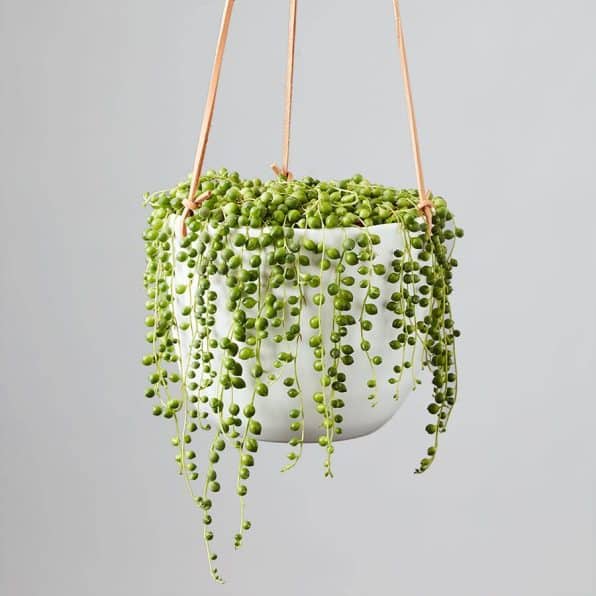
What is a String of Pearls Plant?
The String of Pearls plant (Senecio rowleyanus) is a charming succulent that is indigenous to South Africa and renowned for its distinctive appearance. It features slender stems that can reach several feet in length and are adorned with tiny, pearl-like leaves that give it its name.
This plant is often cultivated in hanging baskets, allowing its vines to gracefully cascade. It requires bright, indirect light and well-draining soil, and should be watered infrequently to avoid root rot.
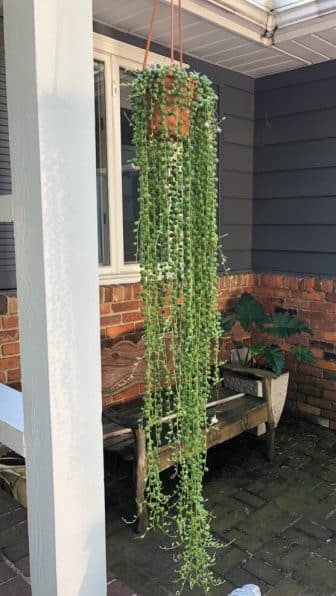
String of Pearls plant emits a delightful cinnamon-like fragrance, and during the growing season, it produces small white flowers that further enhance its beauty. As a relatively short-lived plant, generally around 5 years, it's recommended to propagate it frequently to ensure its longevity.
String of Pearls Plant Basics:
| Common Name: | Spring of Pearls, String of Peas, String of Beads and Rosary vine |
| Botanical Name: | Curio rowleyanus(formerly Senecio rowleyanus) |
| Plant Type: | Succulent |
| Size: | 1-2 ft tall. 1-2 ft long |
| Light: | Full-partial |
| Soil: | Sandy well-draining, neutral to acidic pH |
| Water: | Once every 2 weeks |
| Vulnerabilities: | Over-watering, mealy bugs, fungus gnats, aphids |
| USDA Growing Zones: | 9-12 |
How to Care for String of Pearls
String of Pearls is not an overly finicky plant and is easy to care for and maintain. Proper watering and fertilizing will enhance its growing cycles and pruning and propagation will ensure you enjoy this little pearl for many years.
Best Soil Choice for String of Pearls
The best choice of soil for String of Pearls is a well-draining succulent mix. This type of soil will help to prevent root rot, which is a common problem for succulents. You can buy a succulent mix at most garden centers, or you can make your own by mixing together equal parts potting soil, perlite, and sand.
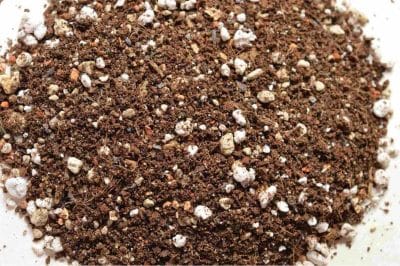
Here are some tips for choosing the right soil for your String of Pearls:
- The soil should be loose and airy so that water can drain quickly.
- The soil should be free of clay, which can hold too much water.
- The soil should be slightly acidic, with a pH of 6-7.
Watering Requirements for String of Pearls
String of Pearls are very sensitive to overwatering, so it is important to water them correctly. They should be watered deeply when the soil is dry, but allow the soil to dry out completely between waterings. If you overwater your String of Pearls, the leaves will start to shrivel and fall off.
Here are some tips for watering your String of Pearls:
- Water deeply when the soil is dry.
- Allow the soil to dry out completely between waterings.
- Do not let the plant sit in water.
- Water in the morning so that the leaves have time to dry before nightfall.
- Use a watering can with a fine spout to avoid splashing the leaves.
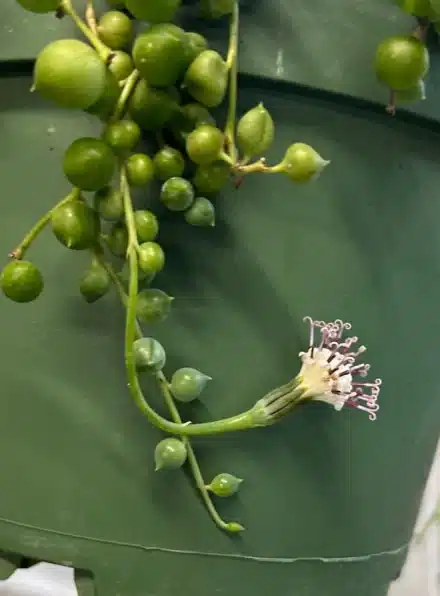
If you are not sure how often to water your String of Pearls, you can always stick your finger in the soil to check if it is dry. If the top inch of soil is dry, it is time to water.
String of Pearls Light Requirements
String of Pearls require bright, indirect sunlight. This means that they should be placed in a spot where they will get some direct sunlight in the morning or evening, but not all day long. If they are placed in direct sunlight for too long, their leaves will start to shrivel and burn.
Here are some tips for providing your String of Pearls with the right amount of light:
- Place your plant in a spot where it will get bright, indirect sunlight.
- Avoid placing your plant in direct sunlight, especially during the hottest part of the day.
- If you live in a hot climate, you may need to move your plant to a shadier spot during the summer months.
- You can also use a sheer curtain or shade cloth to help protect your plant from too much sun.
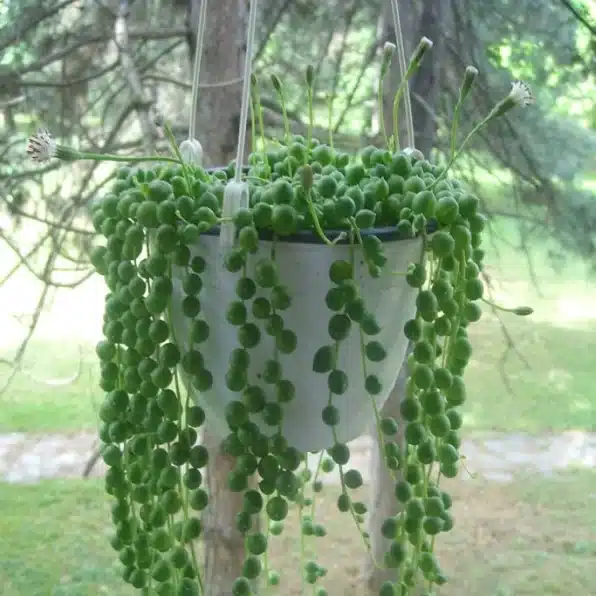
If your String of Pearls is not getting enough light, its leaves will start to stretch and become thin. If your plant is getting too much light, its leaves will start to shrivel and burn.
Temperature & Humidity Needs
String of Pearls are native to South Africa, so they prefer warm, dry climates. They can tolerate a wide range of temperatures, but they do best in temperatures between 60 and 80 degrees Fahrenheit. They are also relatively drought-tolerant, but they will appreciate a little bit of humidity. If you live in a dry climate, you can mist your plant occasionally or place it on a pebble tray to help increase the humidity around it.
Here are some tips for providing your String of Pearls with the right temperature and humidity:
- Keep your plant in a warm, dry spot.
- Avoid placing your plant in cold or drafty areas.
- If you live in a dry climate, you can mist your plant occasionally or place it on a pebble tray to help increase the humidity around it.
If your String of Pearls is not getting enough warmth, its growth will slow down. If your plant is getting too much warmth, its leaves will start to shrivel and fall off. If your String of Pearls is not getting enough humidity, its leaves will start to wrinkle and fall off.
Fertilizing the Plant
String of Pearls are relatively low-maintenance plants, but they do benefit from a little bit of fertilizer. You can fertilize your plant once a month during the spring and summer months with a balanced liquid fertilizer diluted to half strength. Be sure to avoid fertilizing your plant during the winter months, when it is dormant.
Here are some tips for fertilizing your String of Pearls:
- Use a balanced liquid fertilizer diluted to half strength.
- Fertilize your plant once a month during the spring and summer months.
- Avoid fertilizing your plant during the winter months.
- Do not fertilize your plant if the soil is wet.
If you over fertilize your String of Pearls, the leaves will start to turn yellow and fall off. If you notice any of these signs, it is important to stop fertilizing your plant immediately.
Pruning Method
There are a few reasons why you might need to prune your string of pearls plants. One reason is to remove dead or damaged leaves. Another reason is to shape the plant or make it bushier. You can also prune your string of pearls to propagate new plants.
To prune your string of pearls, you will need a sharp pair of scissors or pruning shears. Be sure to sterilize the scissors with rubbing alcohol before you start pruning. To remove dead or damaged leaves, simply snip them off at the base of the stem. If you are shaping the plant, you can snip off some of the longer stems to make it shorter and bushier.
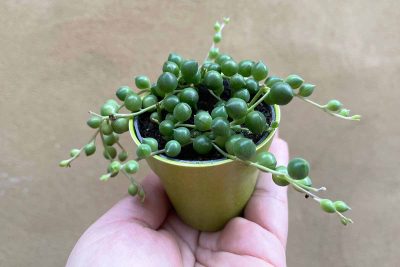
How to Propagate String of Pearls
- Choose a healthy stem from your string of pearls plants.
- Use a sharp knife or scissors to make a clean cut just below a node.
- Remove the bottom leaves from the cutting.
- Plant the cutting in a pot of well-draining succulent soil.
- Water the cutting lightly and place it in a bright, indirect light location.
- Keep the soil moist but not soggy.
- New roots should start to form within a few weeks.
- Once the cutting has established roots, you can water it more regularly.
With proper care, your new String of Pearls plant will thrive for many years to come.
Here are some additional tips for propagating String of Pearls:
- You can propagate String of Pearls in water or soil.
- If you propagate in water, be sure to change the water every few days.
- If you propagate in soil, use a well-draining succulent mix.
Similar Plants to the String of Pearls
Here are some other plants that are similar to String of Pearls. These plants are all succulents, which means that they have thick, fleshy leaves that store water. They all require similar care, which includes bright, indirect sunlight, well-draining soil, and infrequent watering.
| String of Bananas | Senecio radicans | Cactaceae | String of Fishhooks, String of Coral |
| String of Dolphins | Senecio peregrinus | Cactaceae | String of Flying Dolphins |
| String of Hearts | Ceropegia woodii | Asclepiadaceae | Rosary Vine, Heart Plant |
| String of Buttons | Crassula perforata | Crassulaceae | String of Rupees, String of Fishhooks |
| String of Raindrops | Dischidia nummularia | Apocynaceae | String of Jade |
| String of Pickles | Othonna capensis | Crassulaceae | String of Jade |
| String of Nickels | Dischidia nummularia | Apocynaceae | String of Jade |
| String of Turtles | Peperomia prostrata | Piperaceae | Peperomia Turtle |
- String of Bananas: a fast-growing succulent that is easy to care for. It is a popular choice for beginners and experienced plant owners alike.

- String of Dolphins: a unique and eye-catching succulent with dolphin shaped leaves.
- String of Hearts: a charming and delicate succulent with tender vines and heart-shaped foliage. It is a relatively easy plant to care for, but it is important to avoid overwatering.

- String of Buttons: a unique and unusual succulent. It is a relatively low-maintenance plant perfect for those looking for something different.
- String of Raindrops: a delicate and beautiful succulent that is sure to add a touch of elegance to any home. It is a relatively easy plant to care for, but it is important to avoid overwatering.
- String of Pickles: a playfully-named succulent that is sure to add a touch of personality to any home. It is a relatively low-maintenance plant perfect for those looking for something different.
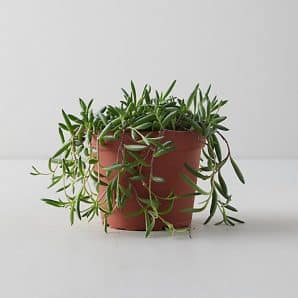
- String of Nickels: a fast-growing succulent that is sure to add a touch of elegance to any home. Green coins hanging from a vine.
- String of Turtles: a unique and unusual succulent that is sure to add a touch of personality to any home. It is a relatively low-maintenance plant that is perfect for those who are looking for something different.

Common Problems with String of Pearls Plant
You may have some common problems when you are dealing with the String of Pearls plant care that you need to be aware of. Problems that can be detrimental to the life of your plant if not taken care of.
Growing
Overall growth can be a problem when these are factors:
Overwatering: String of Pearls plants are succulents, which means they store water in their leaves. Overwatering can lead to root rot, which can kill the plant. It is important to water String of Pearls plants only when the soil is completely dry.
Underwatering: String of Pearls plants can also suffer from underwatering. When the plant is underwatered, the leaves will start to shrivel and turn brown. It is important to water these plants regularly, but not too much.
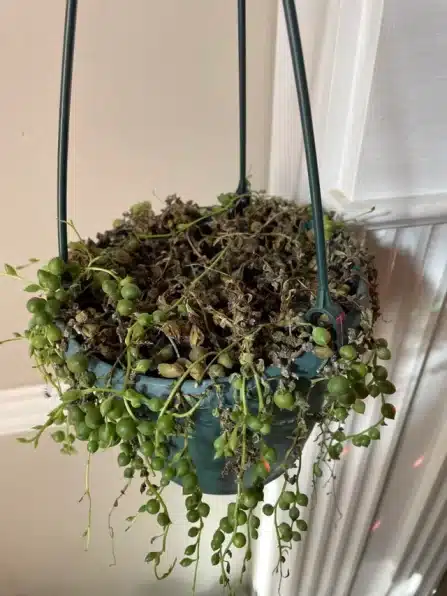
Not enough sunlight: String of Pearls plants need bright, indirect sunlight to thrive. If they do not get enough sunlight, the leaves will start to stretch and become leggy. It is important to place your plants in a spot where they will get at least 6 hours of sunlight per day.
Too much sunlight: Your plants can also be damaged by too much sunlight. If the plant is exposed to direct sunlight, the leaves will start to turn brown and crispy. It is important to place String of Pearls plants in a spot where they will get bright, indirect sunlight.
Not enough fertilizer: String of Pearls plants need to be fertilized regularly, especially during the spring and summer months. A balanced fertilizer can be used once a month.
Diseases
Root rot: Root rot is a fungal infection that can cause the plant's roots to rot and die. It is usually caused by overwatering. Symptoms of root rot include yellowing leaves, wilting, and mushy roots. If you suspect your plant has root rot, it is important to repot it in a new pot with well-draining soil and to water it less frequently.
Viruses: There are a number of viruses that can affect String of Pearls plants. Symptoms of viral infections can vary, but they may include yellowing leaves, stunted growth, and leaf spots. There is no cure for viral infections, but you can help prevent them by keeping your plant healthy and by avoiding contact with infected plants.
Pests
Mealybugs: Mealybugs are small, white insects that suck the sap from plants. They can cause leaves to yellow and fall off. To get rid of mealybugs, you can wipe them off the plant with a cotton swab dipped in rubbing alcohol or insecticidal soap.
Scale: Scale is a type of insect that attaches itself to the stems and leaves of plants. It can cause leaves to yellow and drop off. To get rid of scale, you can scrape it off the plant with a knife or insecticidal soap.
Aphids: They are small, soft-bodied insects that feed on the sap of plants. Aphids can cause leaves to yellow and curl, and they can also spread diseases. To get rid of aphids, you can wash them off the plant with a strong stream of water, or you can use an insecticidal soap or neem oil.
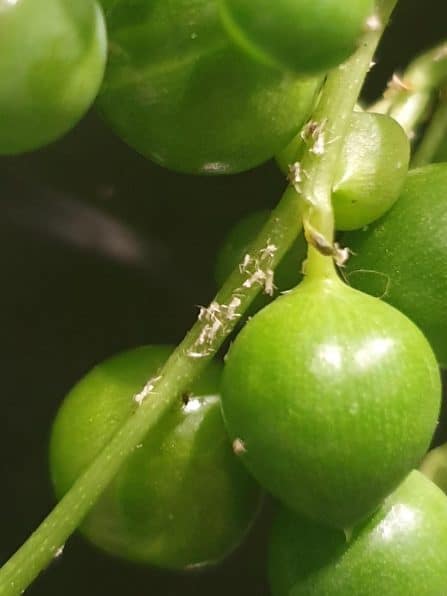
Interesting Facts About the String of Pearls
It may be a fact and it may be a myth. but it is said that the String of Pearls plant can bring you luck and prosperity and that it symbolizes purity, loyalty, and friendship. True or not it is a beautiful thought to clutch.
FAQ’s
Is a String of Pearls plant easy to care for?
The String of Pearls plant is a very easy plant to care for , a perfect beginner houseplant.
Is my String of Pearls plant toxic to cats?
Yes, the String of Pearls plant is toxic to cats, and humans. Probably better not to ingest it.
Why is my String of Pearls dying?
Your String of Pearls plant is very susceptible to over-watering and this could root rot which will eventually kill your plant.
When do String of Pearls flower?
String of Pearls is a summertime bloomer that produces a small yet fragrant white flower.



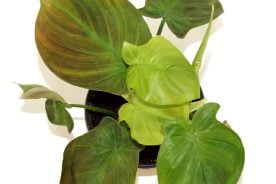

No Comments